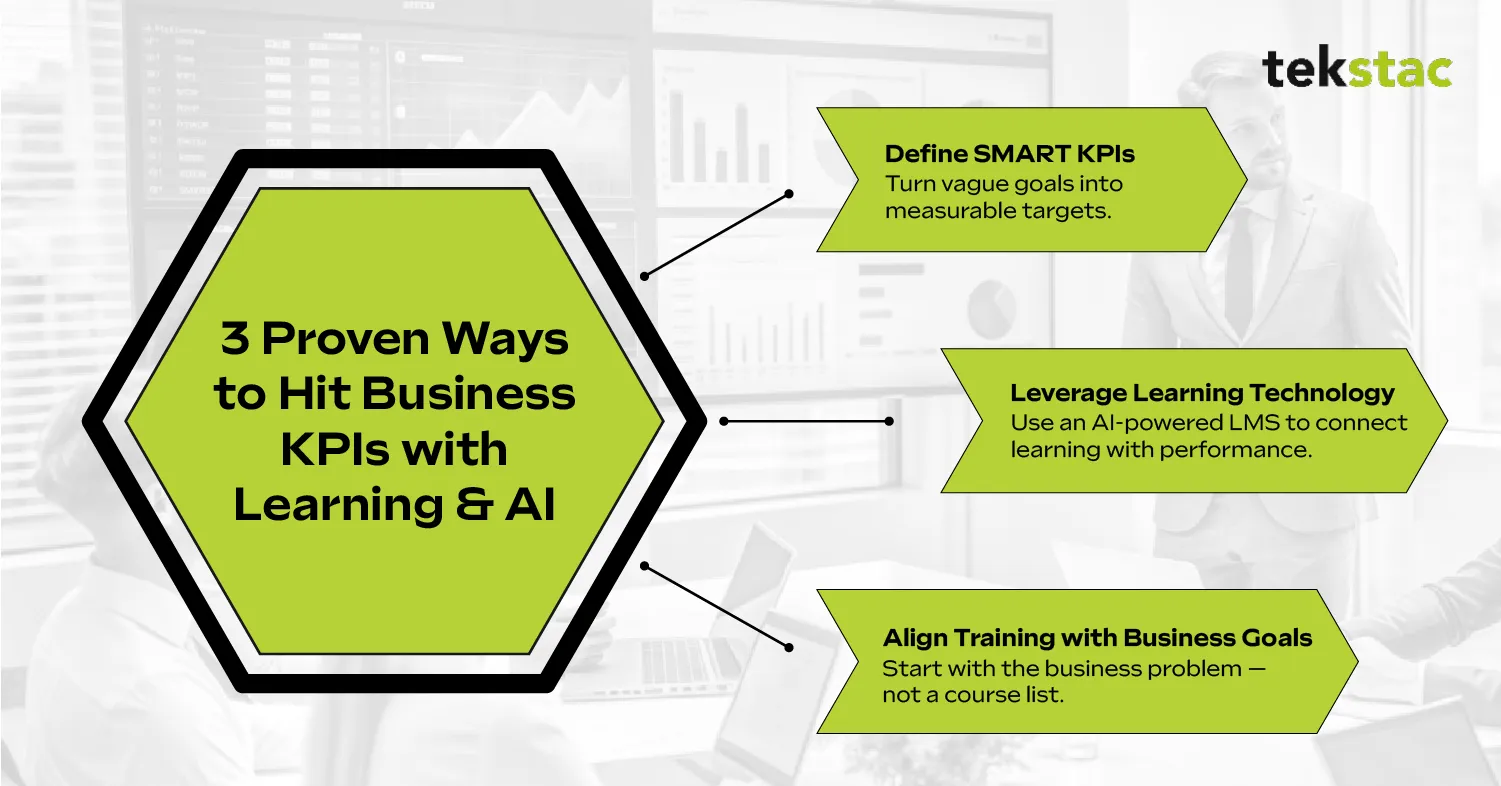How Tekstac Helps L&D Managers Hit Business KPIs Faster

Less than one in three skilling programs today directly impacts business KPIs. The rest? They keep churning out content. It’s no wonder that when L&D functions like a content factory, the business treats learning as optional.
To lead, L&D must become the capability engine: strategic and data driven.
While most of them still measure the traditional surface-level metrics such as:
- Completion rates
- Assessment scores
- Attendance numbers
These numbers still don’t answer the most important question: Did skill development actually change performance?
So how can L&D teams boost business KPIs efficiently?
That’s where platforms like Tekstac come into picture. See how Tekstac helps organizations in reaching learning and development KPIs.
Why Traditional L&D Metrics fail to deliver business KPIs?
Metrics like the number of hours trained or course completions are easy to measure but fail to capture the real training ROI measurement.
Let’s see why.
For instance:
- A team may complete a leadership program, but if decision-making doesn’t improve, is it worth the time?
- Employees may score high on assessments, but if sales numbers don’t change, did the learning truly stick?
L&D should replace activity tracking with meaningful skills gap analysis.
It means mapping current skills to business goals, finding critical gaps, and creating focused upskilling programs to close them.
This shifts L&D from spotting problems to solving them, building the right skills, in the right people, at the right time.
What Defines L&D Business KPI?
L&D business KPIs help organizations move from measuring participation to measuring performance change. Remember to identify the right KPIs for your L&D.
The role of KPIs in L&D:
- Provide visibility into the effectiveness of training programs
- Show measurable ROI on learning investments
- Highlight both strengths and areas for improvement
- Align L&D with organizational strategy
Common Challenges in Measuring Learning & Development KPIs
Did you know? According to the LearnOps Industry Report (2024)33% of organizations don’t make L&D success measurements at all.
Listed below are some of the common challenges faced in tracking business KPIs
1. Proving ROI
One of the biggest hurdles for L&D managers is convincing leadership, that training delivers value. Without robust data, learning is seen as a “nice-to-have” rather than a strategic growth driver.
2. Relying Too Much on Easy-to-Track Metrics
Attendance numbers and retention rates are simple to report, but they don’t tell the full story. True measurement requires both quantitative data (scores, completions, proficiency levels) and qualitative insights (employee satisfaction, perceived value, behavioral change).
Overcoming these challenges requires the right employee performance KPIs, the right measurement approach, and the right technology.
Top 3 Ways Your Teams Can Consistently Hit Business KPIs

1. Define SMART KPIs
Instead of “Improve onboarding,” a SMART KPI would be “Reduce new hire ramp-up time by 20% within six months.”
2. Leverage Learning Technology
To truly measure and maximize the impact of learning, organizations need more than just training delivery—they need visibility, precision, and scalability. This is where an AI-powered Learning Management System (LMS) makes the difference and tracks upskilling impact on KPIs.
A AI-powered LMS can:
- Collect and centralize training data automatically
- Provide real-time dashboards on learner progress
- Personalize learning with skills gap analysis and adapting content
- Deliver insights instantly for leadership reporting
This shifts L&D from being reactive to proactively shaping workforce performance.
3. Align Training with Business Needs
Training should always start with a business problem, not a course catalog. Ask upfront:
- What challenge are we solving?
- Which learning and development KPIs will this training move?
- How will we measure success?
When learning initiatives are designed with these questions in mind, they not only engage employees but also prove their impact to stakeholders.
How Tekstac empowers you to track Business KPIs
Tekstac empowers L&D managers to link training directly to business performance through powerful learning analytics and management tools.
Why Tekstac:
- 360-degree platform with measurable ROI
- 500+ customizable, role-aligned learning paths
- Gamified experience with XP points, badges, and leaderboards
- AI-powered personalization & live dashboards
- Enterprise-grade security & compliance
- Data-driven skills insights
- Dual-layered assessments (auto + video with AI proctoring)
Enhanced learning experience with Tekstac
Beyond L&D success measurement, Tekstac powers learning delivery with:
- Personalized learning paths for every employee
- Mentor marketplace and virtual sessions
- Auto-evaluated practice labs
With 1 million+ professionals upskilled, 24 million+ learning hours, and enterprise clients like IBM, PwC, Capgemini, and Cognizant, Tekstac is proven at scale.
Where Skilling Meets Measurable Business KPIs
It’s time to stop tracking skill development for just the numbers. Instead of asking “Did employees finish the course?”, L&D managers must ask “What business KPI did this program improve?”
Track what matters and focus more on metrics stakeholders already value. Identify the employee performance KPIs before launching a program.
Need assistance with all this?
Tekstac transforms L&D from tracking hours and completions to driving measurable performance, stronger KPIs, and a future-ready workforce.
FAQs on business KPIs in L&D?
1. What are some examples of business KPI metrics in L&D?
Some examples for this include time to competency for new skills, utilizing acquired abilities in practical projects, Return on Learning Investment (ROLI).
2. What is KPI for L&D?
Learning and development KPIs are the steps you complete along the way in training. These KPIs for learning give you a meaningful way to quantify what good results are.
3. Which is a must track learning and development KPI?
One significant KPI one must track is training ROI, which measures the total value derived from training programs compared to their cost.





